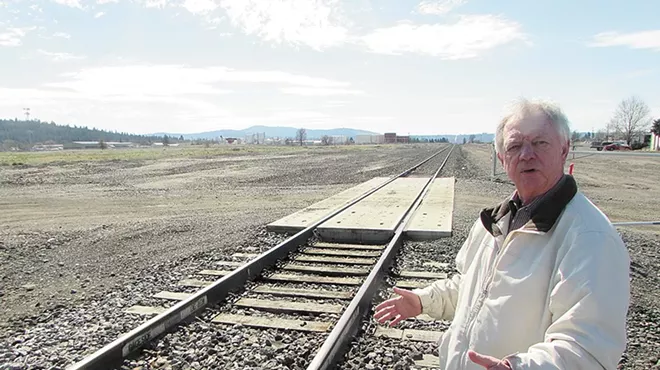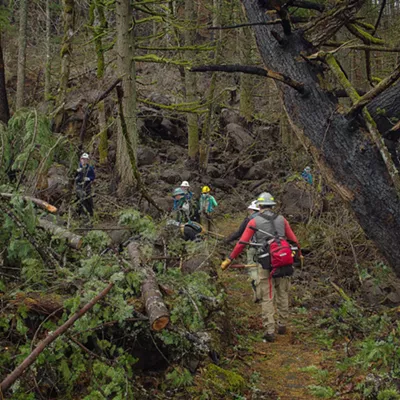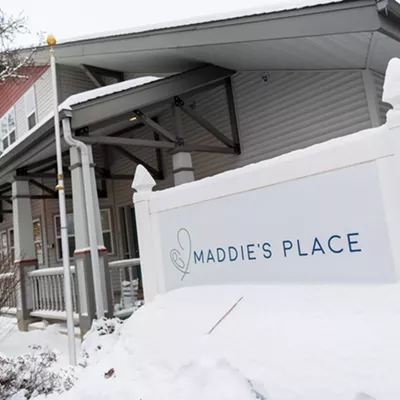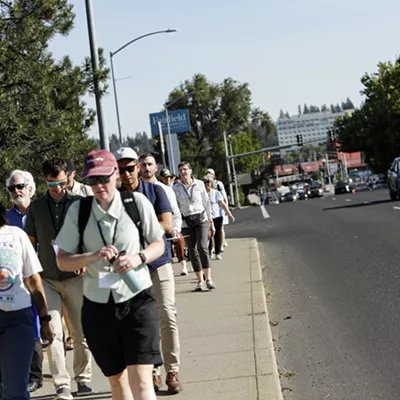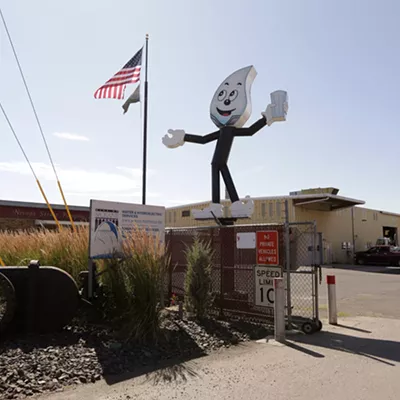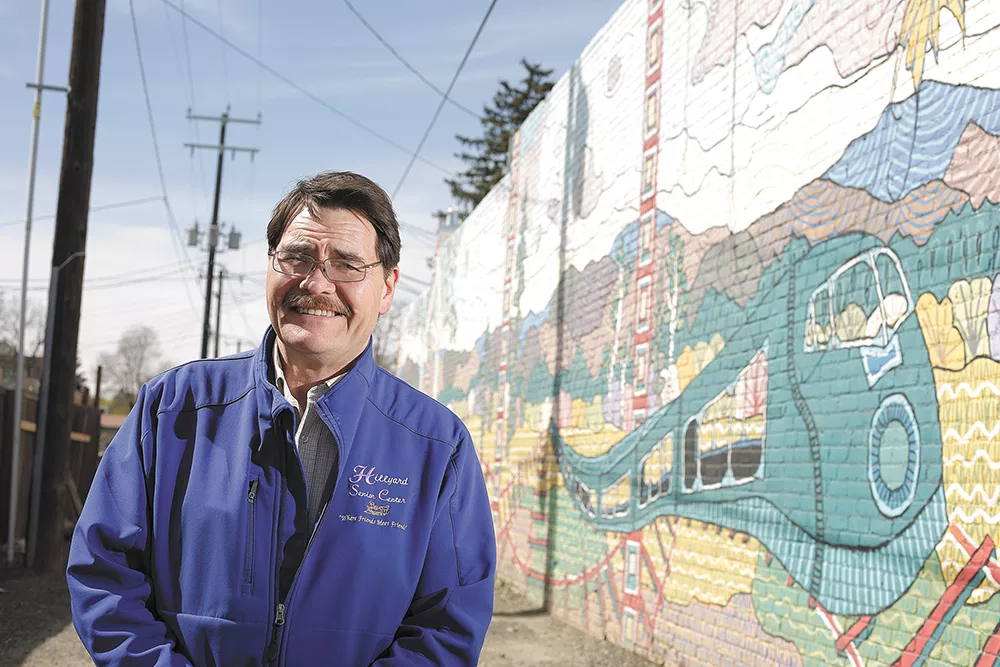
TO MARKET, TO MARKET
Jobs. Streets. Crime. Those are the three things City Councilman Mike Fagan hears about when he knocks on the doors of his Hillyard constituents.
"Here we have a community that was basically comprised of nothing but antique shops and closed businesses, and we need to see about finding the spark," Fagan says. "Here we're rising up from the ashes, trying to come back alive."
We're walking down Market Street, Hillyard's most iconic arterial, on a sunny Saturday. Market is the first station on the journey to Hillyard's resurrection. The multimillion-dollar revitalization of the street and sidewalk was finished in 2009, complete with bright new streetlights equipped with plug-ins. Market Street is ready for the electric car. But for every nod to the future on Market Street, there's a nod to history. Locomotives and railroad symbols are stamped on the sidewalks and grates. Brightly colored murals shine down from the brick walls, celebrating the old trains that ran through here and the old cars that were sold here. In Hillyard, the past always remains present.
THE LAST TRAIN OUT OF HILLYARD
From his portrait, railroad tycoon James Hill gives a frown — an imperious frown, worthy of the man they called the Empire Builder — under his long Rutherford B. Hayes beard. The railroad built Hillyard. There was a time when Hillyard's shops churned out 530-ton Great Northern Mallet steam locomotives; when Hillyard's mayoral elections swung because of the power of the railroad union; when "'War to Death' in Rail Strike" topped the Spokane Daily Chronicle, as 1,600 Great Northern locomotive machinists refused to report for work.
Yet Spokane's rebirth — the World's Fair transformation of a polluted railroad yard into the city's iconic park — also symbolized the beginning of the end for the Hillyard railroad industry. A three-way railroad merger turned the Hillyard route from a main line to a mere local branch. It was like cutting off the flow of blood to a limb. In 1982, the limb itself fell off. Ninety years after Hillyard was founded, Burlington Northern shuttered Hillyard's railroad shop.
"The railroad," Spokesman-Review declared that year, "has all but shut the door on Hillyard."
Eighteen years later, the community's other major employer — the Kaiser Aluminum smelting plant to the north — shut down. The loss of the railroad was the wound. The loss of Kaiser was the salt.
LAUNDRY, LIBRARY, LIQUOR
The Hillyard Laundry Building is not a laundry. Once it was a laundry — a century ago, when Kisaburo Shiosaki and his kids hand-rolled soapy clothes across washboards. Then it was a bookstore. Today it sells vintage odds and ends. By June, it will have transformed into an ice cream parlor.
The Hillyard Library is not a library. Once it was a library. Then it was a church, and then another church. And now, like a lad mag tucked inside a schoolbook, it's become a man-cave style sports bar where the waitresses are called "librarians." And it's a barbershop. And a virtual golf simulator.
As a nod to the building's old use, an illustration of a bosomy redhead peers over reading glasses on a sign labeled "NACHO LIBRARIAN." Her knowledge of the Dewey Decimal System, frankly, seems limited.

FORK IN THE ROAD
Richard Burris holds his hands up in the air, above the railroad tracks, the tumbleweeds and the dusty expanse behind Market Street. Around here, in a vague sense, is the future site of the long-anticipated North Spokane Corridor. But the fate of Hillyard hinges on what happens in the next decade, when the vague gets specific.
Burris, of the Greater Hillyard Business Association, speaks slowly, laconically, peering over his glasses. If the freeway is built correctly, he says, "it could be the best thing for Spokane since the railroad... The potential is absolutely enormous."
And so is the danger. If it's done incorrectly, he says, it would be a complete economic disaster.
The crisis lurks 170 feet underground, where petroleum from an old railroad refueling project stretches across 7 acres. Cleanup could take two decades, and it's right in the proposed path of the highway. The Washington State Department of Transportation has floated a solution: curve the highway a bit to the west and elevate it up above the railroad tracks near Market Street.
If that happens, Burris warns, Market Street would be trapped under the literal shadow of the freeway, rattled by noise. The freeway would be an eternal impediment dividing Hillyard. It "would basically destroy this business district."
Community members and local politicians rose up against the proposed design. Burris pushes a different plan: Stack the freeway up on pillars, rising above the contaminated area, and allow the cleanup to continue underneath.
Otherwise, he suggests, all the hard work of improving the Hillyard business district goes to waste.
"In one paragraph they could change it, and everything is for naught," Burris says. "[And then] that entire area is a blight, and it always will be."
HILLYARD'S BACKYARD
Take to the skies — or Google Earth — and look down upon the land east of Hillyard's railroad tracks. You'll see a lot of brown. Zoom closer, and you'll find empty lots, and lots of 'em. A few miles away at City Hall, director of planning Lisa Key can show you the map of the area, where vast quantities of land are vacant or underused.
Now overlay the lens of potential. Picture how the 78 acres of old railroad land near downtown Spokane turned into Kendall Yards, a thriving commercial-residential development. Picture multiplying that tenfold. Now picture, instead of townhouses and boutique restaurants, factories and warehouses. Picture jobs. Picture the triumphant return of industry to the community built on it.
"This has a great potential to be a manufacturing incubator for the city," Key says.
The Yard — that's the name of the 800-acre economic zone in eastern Hillyard — aims to tap into that potential. A spot where railway and freeway converge? Now that's a manufacturer's dream.
Or at least it could be. Right now, the gravel and dirt roads don't do much to attract development.
That's one thing the Yard aims to fix. The city will focus on a few of the areas in the Yard with the most explosive potential, improving its infrastructure to attract development. The city of Spokane already has two grants to assist developers with the first stages of environmental studies.
"We want to bring it full circle, to recognize the vibrancy it once was," Key says. "Recognizing that in the heyday of Hillyard, that was a quality community. That's what we're trying to achieve." ♦
UPDATE: The original version of this article incorrectly described the Hillyard Library Sports Bar and Barbershop.



